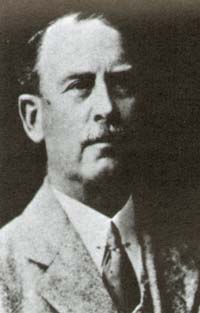Colonel Percy Fawcett
Before we dive into the dangerous and forbidden jungles of South America in search of lost cities, ancient civilizations and secret treasure, it is necessary for you to learn some background.
 Percy Fawcett had always been fascinated
in archaeology and history. He often took long walks, exploring.
In 1893, while a young British officer stationed at Tricomalee,
Ceylon, he ventured out on one of his long walks into the remote
jungle areas of the island.
Percy Fawcett had always been fascinated
in archaeology and history. He often took long walks, exploring.
In 1893, while a young British officer stationed at Tricomalee,
Ceylon, he ventured out on one of his long walks into the remote
jungle areas of the island.
That day, a storm overtook him, forcing him to seek refuge for the night under some trees. The following morning, much to his surprise, he discovered a huge rock with strange inscriptions of unknown character and meaning.
He copied
the inscriptions and showed them to a Buddhist priest. The priest
informed Fawcett that the inscription was a form of old Asoke-Buddhist
that only those priests could understand. Ten years later, a
Ceylonese Oriental Scholar at Oxford University confirmed the
ascertion.
Fawcett now had a keen interest in esoteric history and lost
civilizations. During his army career, he led eight (8) South
American expeditions under contract with the Bolivian and Brazilian
governments to delimit the frontiers that these two countries
shared with Peru and Ecuador.
In 1911, at a lecture before the Royal Geographic Society in London, Fawcett described the "lost world" on the borders of Bolivia and Brazil. In attendance was Sir Arthur Conan Doyle, creator of Sherlock Holmes and author of a book based on Fawcett's tales, The Lost World: The Adventures of Professor Challenger.
Later, H. Rider Huggard (author of King Solomon's Mines) gave Fawcett a mysterious twelve-inch-long basalt statue. Haggard told Fawcett that he had received the stone idol from the British Consul, O'Sullivan Beare, who in turn had picked it up in a lost city in Brazil in 1913. Based on the inscription, the idol was thought (hoped?) to have an Atlantean origin. Like a good luck charm, in 1925 Colonel Fawcett carried this stone statue with him on his fateful expedition into the Amazon rainforest.
 Percy
Fawcett was a true believer in the mythological Atlantis. However,
he did not believe that the origin of Atlantis could be found
in Brazil, but rather Brazil was once a colony of Atlantis. And
it was his hope to prove the existence of Atlantis by rediscovering
this lost city.
Percy
Fawcett was a true believer in the mythological Atlantis. However,
he did not believe that the origin of Atlantis could be found
in Brazil, but rather Brazil was once a colony of Atlantis. And
it was his hope to prove the existence of Atlantis by rediscovering
this lost city.
Years later, however, the basalt statue was found to have originated in the Mediterranean region circa 400 BC at Hallicarnassus before Hellenistic times.
IMPORTANT: According to Barry Fell, an authority on deciphering many ancient inscriptions, the statue is an image of a priest of Baal advertising his temple that was dedicated to Hercules (Melgart, son of Baal and Tanitte.) Fell concluded the language was Creole Minoan-Hittite and read: "To ask the Gods for a lucky omen of the future, invoke Melgart and ... bring a propriation for him."
Apparently, during ancient Mediterranean times (where many diverse cultures thrived) it was common for different countries to form alliances and work together for economic or political ventures. Therefore, a combination of languages such as Minoan-Hittite would be used on a statuette left at one of the lost cities.
But how did this ancient statue find its way to a lost city in the Amazon jungle?
This statue (in addition to other ancient Mediterranean artifacts found in the interior of Brazil, such as a Dorian coin, which I will explain later) appears to prove that Brazil was being exploited commercially by Mediterranean traders long before Spanish explorers discovered South Americ!
With this understanding, it is now a probability that ancient mines and trading centers were developed in South America prior to 500 BC by the people of the Mediterranean region, namely Egyptians, Phoenicians, and later Ptolemaic Greeks.
Fawcett pointed out that Solimoes was the native name of the Amazon, which is also the same as Soloman or Solomon, suggesting the ships of King Solomon and King Hiram of Tyre made voyages to South America many years in the past. Rock inscriptions in the Amazon region even resemble Phoenician letters.
Interestingly enough, evidence appears to be mounting that the mines of Ophir (which I will discuss in the next section) may well have been King Solomon's mines - or the Lost Mines of Muribeca?
Source:
Lost Cities & Ancient Mysteries of South America
by David Hatcher Childress
Please
continue. The stories are about to begin.
|
|
|